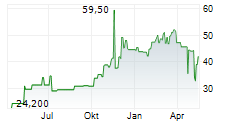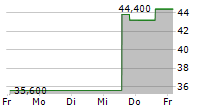
- If approved, vatiquinone would be the first and only authorized therapy for children with FA -
- PTC's fourth approval application submitted to FDA in 2024 -
WARREN, N.J., Dec. 19, 2024 /PRNewswire/ -- PTC Therapeutics, Inc. (NASDAQ: PTCT) announced today the submission of the vatiquinone New Drug Application (NDA) for the treatment of children and adults living with Friedreich ataxia (FA) to the U.S. Food and Drug Administration (FDA).
"We are excited to have reached this important milestone in the development of vatiquinone," said Matthew B. Klein, M.D., Chief Executive Officer of PTC Therapeutics. "The evidence of short- and long-term efficacy as well as the extensive safety data collected, particularly in children, supports the potential for vatiquinone to fill the significant unmet need for children living with Friedreich ataxia as well as provide a potential treatment option for adults living with FA."
The vatiquinone NDA is based on data from the placebo-controlled MOVE-FA study as well as results from two long-term studies including pediatric and adult FA patients. Data from these three studies demonstrate significant, durable and clinically meaningful evidence of slowing disease progression on key aspects of disease. In addition, these studies demonstrate that vatiquinone is safe and well tolerated in all age groups studied.
The vatiquinone NDA is the fourth approval application PTC has submitted to the FDA this year. The BLA for its AADC gene therapy was submitted in March 2024 and approved in November 2024. NDAs for sepiapterin, for the treatment of adults and children living with phenylketonuria (PKU) and for Translarna (ataluren) for the treatment of boys and young men with nonsense mutation Duchenne muscular dystrophy, have been also submitted and accepted for review.
About Vatiquinone
Vatiquinone is a small molecule, first-in-class selective inhibitor of 15-Lipoxygenase (15-LO), an enzyme that is a key regulator of the energetic and oxidative stress pathways that are disrupted in Friedreich ataxia. Inhibition of 15-LO helps to alleviate the consequences of mitochondrial dysfunction and oxidative stress, ultimately decreasing cellular inflammation and oxidative stress and promoting neuronal survival.1,2,3 Vatiquinone has been evaluated in a number of clinical studies, many focused on pediatric patients, and has demonstrated an impact on mortality risk and a number of neurological and neuromuscular disease symptoms.
About MOVE-FA
MOVE-FA was a global registration-directed trial of vatiquinone that enrolled 146 pediatric, adolescent and adult FA patients, the majority of whom were under 18 years of age. While the primary endpoint of change from baseline in the overall mFARS score did not reach statistical significance (p=0.14), a statistically significant effect (p=0.021) was recorded on the mFARS upright stability subscale, which was a pre-specified endpoint, and the portion of the mFARS now understood to be the most sensitive and relevant for the enrolled primary analysis population. In addition, the effect on upright stability was concordant with favorable treatment effect on the 1-minute walk distance test and the functional component of the Modified Fatigue Rating Scale. The study included a 72-week placebo-controlled phase and a long-term open-label extension. Following completion of MOVE-FA, subjects were eligible to enroll in a long-term, open-label extension study which is ongoing.
About Friedreich Ataxia
Friedreich ataxia (FA) is a rare, physically debilitating, life-shortening, neuromuscular disorder that mainly affects the central nervous system and the heart.4 It is the most common hereditary ataxia (abnormal, uncoordinated movements) and is usually caused by a single genetic defect in the frataxin (FXN) gene that leads to reduced production of frataxin, a mitochondrial protein that is important for cellular metabolism and energy production.4,5 Decreased frataxin levels are associated with mitochondrial iron accumulation and increased oxidative stress, which can lead to cell death through ferroptosis.6,7,8
Symptoms include progressive loss of coordination and muscle strength leading to poor balance and coordination, difficulty speaking, swallowing, and breathing, curvature of the spine, serious heart conditions, diabetes, and hearing and vision impairment.9,10 The severity of symptoms and speed of progression varies between people and some symptoms may not be evident in all. Friedreich ataxia is usually diagnosed in childhood or adolescence.5,11 Approximately 25,000 people have Friedreich ataxia globally.
About PTC Therapeutics, Inc.
PTC is a global biopharmaceutical company that discovers, develops and commercializes clinically differentiated medicines that provide benefits to children and adults living with rare disorders. PTC's ability to innovate to identify new therapies and to globally commercialize products is the foundation that drives investment in a robust and diversified pipeline of transformative medicines. To learn more about PTC, please visit us at www.ptcbio.com and follow us on Facebook, Instagram, LinkedIn and X.
For More Information:
Investors:
Ellen Cavaleri
+1 (615) 618-6228
[email protected]
Media:
Jeanine Clemente
+1 (908) 912-9406
[email protected]
Forward-Looking Statement
This press release contains forward-looking statements within the meaning of The Private Securities Litigation Reform Act of 1995. All statements contained in this release, other than statements of historic fact, are forward-looking statements, including statements regarding: the future expectations, plans and prospects for PTC, including with respect to the expected timing of regulatory submissions and responses, commercialization and other matters with respect to its products and product candidates; PTC's strategy, future operations, future financial position, future revenues, projected costs; the extent, timing and financial aspects of our strategic pipeline prioritization and reductions in workforce; and the objectives of management. Other forward-looking statements may be identified by the words, "guidance", "plan," "anticipate," "believe," "estimate," "expect," "intend," "may," "target," "potential," "will," "would," "could," "should," "continue," and similar expressions.
PTC's actual results, performance or achievements could differ materially from those expressed or implied by forward-looking statements it makes as a result of a variety of risks and uncertainties, including those related to: the outcome of pricing, coverage and reimbursement negotiations with third party payors for PTC's products or product candidates that PTC commercializes or may commercialize in the future; expectations with respect to vatiquinone, including any regulatory submissions and potential approvals, commercialization, the potential achievement of regulatory and sales milestones and contingent payments that PTC may be obligated to make; significant business effects, including the effects of industry, market, economic, political or regulatory conditions; changes in tax and other laws, regulations, rates and policies; the eligible patient base and commercial potential of PTC's products and product candidates; PTC's scientific approach and general development progress; and the factors discussed in the "Risk Factors" section of PTC's most recent Annual Report on Form 10-K, as well as any updates to these risk factors filed from time to time in PTC's other filings with the SEC. You are urged to carefully consider all such factors.
As with any pharmaceutical under development, there are significant risks in the development, regulatory approval and commercialization of new products. There are no guarantees that any product will receive or maintain regulatory approval in any territory, or prove to be commercially successful, including vatiquinone.
The forward-looking statements contained herein represent PTC's views only as of the date of this press release and PTC does not undertake or plan to update or revise any such forward-looking statements to reflect actual results or changes in plans, prospects, assumptions, estimates or projections, or other circumstances occurring after the date of this press release except as required by law.
References:
- Hinman A, et al. PLoS one. 2018;13:e0201369.
- PTC Therapeutics. EPI-743 Pre-Clinical Data Deck.
- Shrader WD, et al. Bioorg Med Chem Lett. 2011;21:3693-3698.
- Lynch DR, Farmer JM, Balcer LJ, et al. Arch Neurol?2002;59(5):743-747.
- Campuzano V, Montermini L, Lutz Y, et al. Hum Mol Genet 1997;11(6):1771-1780.
- Campuzano V, et al. Hum Mol Genet. 1997;6:1771-1780.
- Cook A, Giunti P. Br Med Bull. 2017;124:19-30.
- Pandolfo M, Hausmann L. J Neurochem. 2013;126:142-146.
- Bürk K. Cerebellum Ataxias 2017;4:4.
- Cook A, Giunti P. Br Med Bull 2017;124(1):19-30.
- Delatycki MB, Williamson R, Forrest SM.?J Med Genet 2000;37(1):1-8.
SOURCE PTC Therapeutics, Inc.





